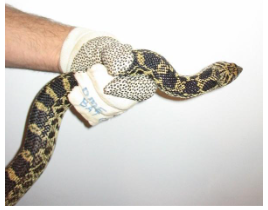This module discusses how to handle and treat wildlife under the direct control of a person, trap, or other control method.
Preparation
Proper animal handling begins before the animal is captured. Use high-quality equipment and ensure it is in proper working order. Initial equipment includes durable, heavy leather gloves, such as welding gloves, and a blanket made of smooth but durable fabric, such as denim.
Handling Snakes

Proper handling of a non-venomous snake.
Photo by Stephen Vantassel
Snakes require more specific handling information and skills than other wildlife. Whenever possible, use snake tongs to handle snakes. Most people lack the experience to distinguish between non-venomous and venomous snakes. Even a non-venomous snake can inflict a painful bite requiring medical treatment. Hold a snake behind the head to avoid being bitten; support its body to reduce the likelihood of it suffering injury as it struggles. Be careful how hard you squeeze the snake with the jaws of the snake tongs, as the vertebrae of snakes are easily crushed. Tongs with wide, flat jaws are less likely to injure snakes.
Place the captured snake in a pillowcase and tie the end securely, ensuring that the snake is not in the knot. When transporting a snake, place the pillowcase in a bucket, cooler, or other hard-sided container with a cover to prevent the snake from injuring itself. Always ensure that animals have proper ventilation. Place captured snakes in a cool, preferably shaded, area between 40° and 75°F.